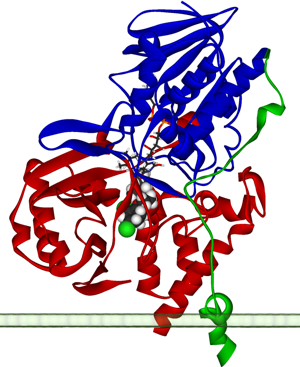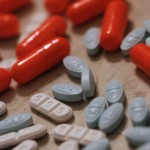Since I’ve written several posts on my growing worries about antidepressants, I thought I’d tell you about the one I’m taking now.
Emsam has worked for me longer than any other, and the dietary restrictions it requires have been a small price to pay.
Among antidepressants, the MAOI class has been relegated to 3rd or 4th tier treatment after other medications have failed. That’s how I started taking Emsam. After a dozen years spent trying 20 meds without success, I was a good candidate for a drug of last resort.
Recently, I’ve gotten curious about how these antidepressants work and why you have to leave certain foods out of your diet when taking them. I’m no expert in neurobiology, but I think I get the gist of what MAOIs do and the problems they cause. I’m adding references at the end of the post so you can get the full story, told in vivid technical color.
What’s an MAOI?
MAOI stands for monoamine oxidase inhibitor. MAOIs do what almost all the other antidepressants on the market do. They increase the level of one or more of the three neurotransmitters thought to be related to depression: serotonin, norepinephrine and dopamine.
Unlike the more recent antidepressants, the MAOIs act on all three, especially dopamine.
Antidepressants increase the available amounts of these monoamines by interfering with the breaking down of neurotransmitters after they’ve served their purpose. That purpose is to carry messages from one neuron to another across a gap called the synapse.
The antidepressants increase the amount of the neurotransmitters available in that gap outside the neuron cell.
After they’ve done their work, they are brought back inside the neuron they came from and are broken down for reuse. There are several steps in that breakdown process, and antidepressants of different types specialize in slowing down one or another of those steps.
The most widely prescribed drugs are reuptake inhibitors. (For example, Prozac is a selective serotonin reuptake inhibitor – SSRI) They interfere with the transporter proteins that take the neurotransmitters back to be reprocessed.
MAOIs target the enzyme (monoamine oxidase) that triggers the actual breakdown of the neurotransmitters into other chemical substances.
The basics are summarized in the name, MAOI.
-
Monoamine (MA) is the general name for a large group of neurotransmitters.
-
Monoamine oxidase (MAO) is an enzyme serving as the catalyst needed for the neurotransmitter breakdown process. (A molecule is pictured above in the squiggly ribbon diagram.)
-
An MAO inhibitor (MAOI) interferes with the action of monoamine oxidase in that process.
The Danger of Stroke.
But there’s a catch to messing around with monoamine oxidase.
The action of the MAOIs also interferes with the processing of a particular monoamine compound called tyramine that is found naturally in the small intestine. Certain foods are especially rich in this same tyramine. When the tyramine in these foods is added to what’s already in your gut, then you’re in trouble.
Though it’s not known exactly how this happens, too much tyramine triggers a huge spike in blood pressure, and that can cause a deadly stroke. Even if you don’t get the stroke, you have to get to a hospital for emergency treatment.
Given this danger, why would you want to take one?
How Effective are MAOIs?
The upside is that they’re much better than other antidepressants.
How good are they? Studies of MAOIs have shown them to be the most effective of all the antidepressants now in use. They’re especially good for treatment resistant cases like mine. Only electroconvulsive therapy has a higher rate of remission.
According to the STAR-D study, 30% of patients had remission of most or all symptoms when treated with a single selective serotonin reuptake inhibitor or SSRI (citalopram). In MAOI studies, the remission rate goes as high as 50%.
But there is the potential problem of that deadly stroke.
Naturally, psychiatrists have to be careful in prescribing any MAOI. Dietary restrictions have to be followed to avoid the tyramine-rich foods. That sort of regimen is hard for a lot of people to follow so many stop taking the antidepressant.
An even greater concern is that suicidal patients might stay on the drug but ignore the food restrictions.
That’s where Emsam comes in. It reduces the risk of the hypertension crisis.
Emsam and Selegiline
Emsam is different from the other MAOIs. First Emsam is not the name of the antidepressant itself but rather the name of the transdermal delivery system (that is, a very high tech patch) that contains an MAOI called selegiline.
The patch provides one improvement, and selegiline gives another.
The older MAOI’s, such as Parnate and Nardil, are taken orally like every other antidepressant. When they hit the small intestine, they stop the breakdown of tyramine and set the stage for the dangerous interaction with the wrong kind of foods.
The patch, however, avoids the gastrointestinal tract and delivers the medication directly to the bloodstream and from there to the central nervous system.
Selegiline is one of a new generation of MAOIs. These newer drugs act more selectively than the old ones. At least at low doses, they do not affect the form of monoamine oxidase that works in the small intestine.
You don’t have to restrict your diet on the low dose. However, at the higher doses, selegiline is not so selective, and the food restrictions kick in.
I take the highest dose.
Foods to Avoid.
Which foods do I have to avoid? Unfortunately, it’s hard to find any two lists that agree completely, but the best science indicates a relatively small number of problem foods.
The hypertensive crisis came to be called the “cheese reaction” because the first cases involved eating nicely aged cheese. Aged is the key word. In addition to cheese, there are many types of aged meat – dried, smoked, cured – as well as sausages like salami that can cause the same reaction. Fresh meat, fish and cheese are OK.
I never was a fan of beef jerky, hard sausage or cured meat (well, I did like bacon). Now that I’m a vegetarian, it doesn’t matter anyway.
I do miss the great aged cheeses of the world,, though I ate them pretty sparingly.
Among other problem foods are fava beans, soy bean curd in many forms (tofu, protein concentrates, miso), sauerkraut, and tap beer. Marmite and other yeast concentrates, are not allowed, but Brewer’s yeast and the yeast used in baking are fine.
Here’s the downside of being a vegetarian and soy fan. Tofu is pretty basic, and it would be nice to have that. At least soy milk is OK.
That’s it. These are the food restrictions backed by scientific evidence.
You may see all sorts of other foods, like raisins, bananas, coffee, chocolate – lots more – that were initially on the list in the 1960s. Those claims were based on isolated cases and haven’t made it through more recent tests.
These limitations have changed my diet, and I’ve been living with them for years. As a trade-off for severe symptoms, dropping a few foods has not been a problem.
I’m still taking Emsam, in combination with lamotrigine (a mood stabilizer), and still doing well. However, I’ve had enough ups and downs in the last year to wonder if it’s the medications that are helping or if it’s everything else I do to stay healthy.
I’ve decided to phase them out because of my concerns about long-term use of any antidepressants. But that’s a story for another post.
Have you ever tried an MAOI? Did it work? Were the food restrictions a problem?
Here are a couple of references with full text available online.
Transdermal Selegiline: The New Generation of Monoamine Oxidase Inhibitors
Monoamine Oxidase Inhibitors: A Modern Guide to an Unrequited Class of Antidepressants



How long after eating the wrong food does a reaction occur? Severe headache behind my eyes for 24 hours. Only food I could think of was pizza I had. Headache didn’t show up until the next afternoon. I had the pizza the night before.
My wife suffered from depression for years, and had tried all types of depression meds. Her doctor put her on Ensam , and about 8 or 9 days later she took her life. Will never know if Ensam played a part in her death or not.
I had a reaction to peanuts last night while on a new does of 10 mg parnate. Heart pounding palpitations and bad gas. Peanuts were not on a some lists but then I found it on a do not eat list after I ate them. Did not go to the hospital but got concerned reading about internal hemmiraging and hypertension. Seems a beta blocker would have helped as needed should an emergency occur. I took parnate due to long term depression and the studies saying it prevents herpes virus completely in mice studies. I did notice that other antidepressants actually triggered my dormant genital herpes virus so I thought I would try parnate. I wonder if emsam would have the same outcome?https://www.sciencenews.org/article/old-drug-reduces-herpes-symptoms-spread-https://www.sciencenews.org/article/old-drug-reduces-herpes-symptoms-spread-animal-testsanimal-testsppression of herpes virus?
I am on the 12 mg does of Emsam but I do not restrict my diet. Because it is not processed in the intestines there has never been a case of hypertension reported. My doctor said don’t go eating 2 pounds of blue cheese at a time but other then that don’t worry about it. Same goes for taking other medications that should be restricted. It is a great drug. There are some European countries where doctors are beginning to use it in anti-aging clinics.
Peace
I really appreciate this write-up on Emsam. I only learned of it just tonight when i was researching a COMT gene variant & a few hyperlinks led me down a trail away from my original target and in the direction of info related to MAOIs. My initial reaction to learning of Emsam was “oh, nice! Something i havent actually tried already!” But as i researched further it started looking like i wasnt going to be a likely candidate after all. In addition to the treatment resistent MDD i also have narcolepsy & it would appear that there are serious interactions between MAOIs & my narcolepsy treatments, which i cannot abandon 🙁
But anyway, my main question/curiosity was actually regarding my surprise that i’d not heard of this before. Ive been under the care of a psychiatrist for MDD for nearly 15 years with little improvement. My medications have been changed dozenS of times & i feel a bit odd knowing that this was never introduced in one of my many doctor visits over the years. I suppose if it crossed his mind maybe he factored in the drug interaction & didnt see the point in mentioning it….but he was treating my MDD before i was diagnosed with narcolepsy….so…maybe its not well known/widely used? He’s a fantastic doctor…im inclined to think it might be a matter of him simply not knowing of this patch either. Has anyone gotten the impression that this Emsam is flying under the radar? Just curious. Thanks
yes, it’s definitely flying under the radar!!!
I started on Nardil years ago. (25). Seemed to stop working and tried lots of others for about 10 years. Ended up trying Emsam and it has worked. I believe my this maoi is the drug that works for me. My father also took nardil and it worked for him. It’s been a few years and emsam is still working.